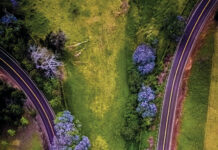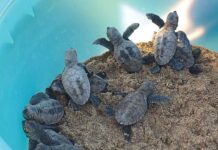Mira Allen, Sky Barnhart, Jill Engledow, Tom Stevens and Shannon Wianeki
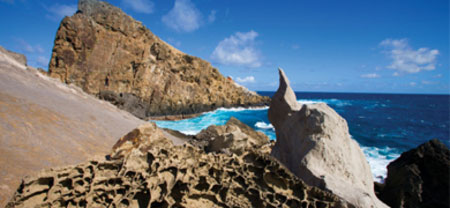 Around here, we look forward to spring—not because of what’s blooming, or how epic the surf’s been, but because it’s when we at Maui No Ka ‘Oi get to champion a handful of Maui folks who work tirelessly to preserve and protect the natural beauty of the island—without pomp, fame, or stock options, we might add.
Around here, we look forward to spring—not because of what’s blooming, or how epic the surf’s been, but because it’s when we at Maui No Ka ‘Oi get to champion a handful of Maui folks who work tirelessly to preserve and protect the natural beauty of the island—without pomp, fame, or stock options, we might add.
Each of these environmental heroes has found a niche in which to channel his or her passion, from preserving coastlines or native forests, to dealing with stuff most of us choose to overlook, like what gets tossed on our roadways, or dumped into our waters. But here we honor them for something more. True heroes, by definition, inspire and lead by example. And in doing so, they elevate us all.
To compile our list, we poke around, solicit comments from readers and all of the people we know, and get the coconut wireless a-jingle. Resoundingly, certain names come back to us over and over. Like epicenters of their own little earthquakes, these folks radiate knowledge and energy into the community, directly inspiring those around them and benefiting the rest of us in ways we sometimes aren’t even be aware of.
Painstakingly restoring an overgrown valley, willingly assuming the advocate’s hot seat, averting the ecological disaster invasive species can wreak—the work is seldom glamorous. But we live on the best island in the world. Like the bumper sticker says:
Lucky We Live Hawai‘i.
Lucky we live among people like these.
Inside Man
“I’ve had a radical label attached to me, but most of what I talk about is common sense,” Rob Parsons tells me.
We’re seated on the lanai of the peaceful Ha‘iku home he shares with his wife, Heather. Trade winds tinkle the wind chimes and flutter the colorful Balinese door-hangings as Rob, barefoot in jeans and a T-shirt, describes the wild ride he was on as Maui County’s first environmental coordinator (EC) under former mayor Alan Arakawa.
“Enjoyable,” “exasperating” and “invigorating” are his words. Among his core projects: an environmental assessment for the harbor system and Superferry, and Na Wai Eha water rights—issues that continue to dominate public attention.
Before Rob’s appointment as EC, “there had been a lot of discussion of things that should be done in Maui County,” says Arakawa. “It became Rob’s job to deal with the different agencies, to look at the laws and regulations, to figure out not only how it should be done, but how it could be done.”
Rob took a proactive approach, meeting regularly with agencies like the Department of Land and Natural Resources and the Maui Invasive Species Committee, appearing on local television and radio talk shows, and answering countless questions on issues of community concern.
He helped secure funds for combating invasive species, and for coastal acquisitions. His work on ocean issues—including supporting a commercial-kayak ban at Ahihi-Kinau Natural Reserve, and instituting the Ma‘alaea Harbor Interim Pumpout Program to eliminate wastewater dumping from commercial boats—has had long-lasting effects.
Along with the successes came the frustration of issues that evoked community conflict—like how to deal with abandoned vehicles and what to do with the “Montana Beach House,” a site acquired by the county that Rob wanted to dedicate as a Maui County Environmental Resource Center, although others wanted it torn down.
Rob learned to appreciate dissent. “Anytime there is opposition, it’s a way to educate,” he says.
These days, he’s known for the “Rob Report,” a column in Maui Time Weekly on topics ranging from palm oil to global warming. “If you give people the information, they are capable of making their own decisions.”
Born in Wisconsin, Rob moved to Hawai‘i thirty years ago, but often returned to work on his brother’s organic farm—an experience that fostered a deep interest in sustainable living. “Maui needs to take great leaps toward self-sufficiency,” he says. “In a disaster, we don’t have a lot in the bank.”
In 2000, Rob took his environmental views into the political arena with a run for County Council. In 2002 he ran for mayor—and wound up as EC.
Will he run for public office again? “More like, I’ll run from it,” he laughs. But he’s leaving his options open.
For now, he’s content to further his advocacy efforts as an environmental consultant and as a board member of Maui Tomorrow and Sierra Club Maui. Lance Holter, chair of the Sierra Club, describes Rob as “fearless in his advocacy for our basic rights to clean air, clean water and clean lands.” Councilmember Jo Anne Johnson calls Rob “a tireless worker for the environment.”
Rob is hopeful about the future. “I think people understand some serious shifts need to take place,” he says.
What can people do to help? “Be conscious of where your money is going; make informed decisions.” Oh, yeah, and read the “Rob Report.”
—Sky Barnhart
Clean-up Woman
“I get carried away,” says Jan Dapitan, describing her dedication to keeping Maui clean and beautiful.
That’s a typically modest Dapitan understatement. “This is a lady who needs to be recognized for what she’s doing, for sheer determination to make things happen,” says Gail Gnazzo, who admired the energy, effort and perseverance of Community Work Day’s executive director even before she went to work there herself. “Anybody who can motivate and keep together a team of 5,000 registered volunteers to keep Hawai‘i beautiful. . . . I’m amazed by it,” Gnazzo says.
“She has the widest circle of friends,” adds Barbara Long, who is working with Dapitan on the restoration of Old Maui High School at Hamakuapoko. “Her interaction with the business community and public inspires people to become volunteers. I think she’s matchless as far as getting corporations, businesses, community organizations—whatever—to donate time, energy and materials. People just don’t say ‘no’ to her.”
Tucked away in an old cottage near the former Pu‘unene School, Community Work Day is one of nearly 600 local affiliates of Keep America Beautiful, a movement that focuses on preventing litter, reducing waste and beautifying communities. Community Work Day’s ongoing projects include paint exchanges (which keep leftover painting supplies out of the landfill by making them available to nonprofits), regular community cleanup days, CompuSwap events to recycle computer equipment, and a county contract to haul away discarded appliances. The organization’s volunteers also take on big projects like restoring the dunes at Kanaha Beach Park and cleaning up thirty-eight miles of Hana Highway. In December, Community Work Day staff came home from the national Keep America Beautiful conference with a first-place award for collaborating on the 2006 Hana Highway cleanup with the state, the county, the community and private companies.
It all happens under the down-to-earth leadership of Dapitan, a woman who uses the word “we” a lot more than “I.”
Dapitan began running Maui’s cleanup program in the 1970s as director of the county Department of Parks and Recreation. When she retired from the county, the Community Work Day program went with her. Hawai‘i’s beautification program was well established by 1995, Dapitan recalls; the Islands were pronounced 75 percent litter free. Then funding dried up, the state litter-control office closed, and “10,000 volunteers across the state were left holding their bags.” Dapitan and others in the statewide network never gave up, but only Maui’s program has truly thrived. Her fans credit Dapitan for its success.
While Dapitan kept the Maui effort growing, her enthusiasm and energy stretched beyond county borders. She went to the Legislature year after year until lawmakers finally came up with $400,000 as a grant-in-aid to revitalize the statewide network.
“Litter is just the beginning,” Dapitan says. “[It’s] an indication that something is wrong with the community. Letting everyone know that littering will not be tolerated is one giant step toward a more livable, peaceful and cooperative community. You’ve got to see the big picture, but you’ve got to do the little things every day—like not litter.”
—Jill Engledow
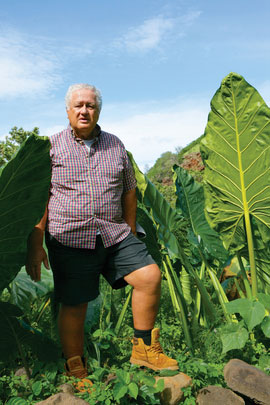 Nature Studies
Nature Studies
After thirty-three years of teaching in Maui’s public schools, the affable Lahaina native retired from the school system, but he didn’t leave his classrooms. He just moved a couple of them outside.
Lindsey’s bigger classroom is five miles long, half a mile wide, and runs from the mountain to the ocean. Instead of desks, chairs and bulletin boards, it has petroglyphs, temple ruins and taro ponds.
It’s Honokowai Valley, a place Lindsey likens to “a natural book, with all the pages still intact.” Since 2000, Ed, his wife Pua, and hundreds of volunteers from all over the world have been clearing the valley of invasive plants, boulder by boulder.
A smaller and more recent teaching venue is high on a West Maui ridge at Hana‘ula, the site of Maui’s first wind farm. There the Lindseys and their volunteers spend Sundays replanting indigenous trees in a tract of native forest displaced by three towering wind turbines.
In both situations, the Lindseys’ nonprofit Maui Cultural Lands, Inc., has negotiated what Ed terms “win-win” relationships with the landowners. Honokowai owner Ka‘anapali Development Corporation, and wind-farm lessor the State of Hawai‘i, gain green karma through Maui Cultural Lands’ work. The organization, in turn, gains regular access to remote sites deemed vital for the restoration of Hawaiian flora and culture.
“I’m not an environmentalist in the Western sense, but a culturalist,” Lindsey explains.
“That’s because my culture depends on the environment and its primordial cadences and rhythms.”
Maui Cultural Lands welcomes volunteers at both sites, but doesn’t need mere sightseers. “The only way to visit us is to work,” grins Ed. His husky physique and strong hands attest to his own labors in family lo‘i (taro paddies) and aboard the twin-hulled Polynesian sailing canoes on which he logged 3,000 nautical miles earlier in life.
At Honokowai and Hana‘ula, “there’s enough work for five lifetimes,” he says, only half-joking. The work includes chain-sawing and chipping invasive trees like guava, haole koa and Java plum to clear space for native Hawaiian plantings. Invasive vines and ground covers must be peeled back and replaced with pili grass, native sedge, and indigenous ground covers like “Hikiaka’s blanket” (Pa‘u o Hikiaka).
Luckily, hundreds of volunteers have answered the call of the conch shell to help at both sites. They include students from a half-dozen Maui schools, visiting Sierra Club members and mainland collegians, Americorps cadets and inmates from the Maui correctional center. The helpers range from preschoolers to octogenarians.
One of the preschoolers is a Lindsey grandson. “My four-year-old grandson asked me a question one time when I was going up to Honokowai,” Ed muses. “He said: ‘Grandpa, why is this important?’ I had to think of an answer a four-year-old can understand, so I told him: ‘Because this is who we are.’”
He adds: “We are really doing this for ourselves, because we as Hawaiian people are the mountains, the sea, the air, the plants, and everything around us.”
Spoken like a true teacher.
—Tom Stevens
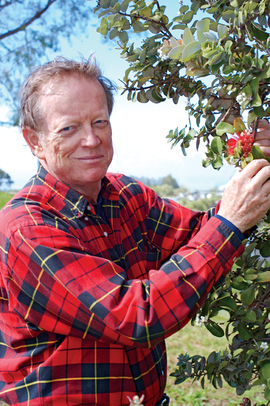 Closing the Loop
Closing the Loop
After a disaster, people are quick to complain that nobody warned them. But rarely do we remember to thank those who do alert us, before we suffer preventable tragedies. Lloyd Loope is such a person. For nearly three decades, Loope has consistently provided Maui’s resource managers, legislators, and the public with the information necessary to protect our island’s irreplaceable natural bounty.
As Haleakala National Park’s first plant ecologist, and later as research biologist for the United States Geological Survey, Loope has lent his expertise to several of Maui’s most significant conservation success stories.
In 1980, when Loope was lured from the Everglades to Haleakala, the park’s rare and spectacular ecosystems were under constant attack from feral ungulates. “Part of my role,” says Loope, “was to provide the scientific background for getting rid of the goats.” It’s hard to imagine, now that the plan has proven so resoundingly successful, that eradicating invasive animals from Haleakala’s summit wasn’t an easy sell. Loope made the case for goats, then for pigs. His feral-pig management plan laid the groundwork for freeing the otherwise pristine Kïpahulu forest from porcine invasion. Then came rabbits; 100 of them were discovered and rapidly removed from Hosmer’s Grove on Loope’s watch. “If we hadn’t succeeded,” Loope told Hawai‘i’s U.S. Senator Daniel Akaka, “the island of Maui, including the cabbage farmers in the upcountry agricultural area, would have had to deal with millions of rabbits within a few years.”
Convincing decision-makers of an issue’s urgency has been Loope’s forte. He alerted legislators to the threat of invasive species such as miconia and fire ants, supported the formation of the invasive species committees, delayed the expansion of the Kahului Airport runway until effective quarantine inspections could be employed, and most recently, stridently encouraged a ban on importing myrtle species into Hawai‘i, thereby protecting native ‘ohia forests from increasingly virulent strains of ‘ohia rust.
He certainly hasn’t done this alone. Throughout his career, Loope has hired and coached some of conservation’s brightest stars: Art Medeiros, Chuck Chimera, Forest and Kim Starr, among others. If a teacher’s worth is measured by that of his students, Loope has ample recommendation.
Chimera relates a story about working for Loope at Haleakala in the early days of miconia control: One weekend, Chuck and a friend decided to hike through the crater’s wet forest down to Hana Highway. They seriously underestimated the hike’s difficulty and spent an extra night in the forest—to the alarm of their families and National Park staff, who discussed deploying helicopters and search-and-rescue teams. When they finally emerged onto Hana Highway, Chuck called his boss to assure him they were safe and apologize for causing so much trouble. Loope listened quietly before responding, “Did you see any miconia?”
“I’ll never forget that,” says Chuck. “Realizing we were both uninjured, and that we just walked through remote native rain forest, Lloyd wanted to know if Maui’s worst weed had reached the area. That’s Lloyd to me: concerned but calm, rational, fact-based, and able to focus on the most important matter at hand.”
Chimera would like to thank his former boss for not overreacting; we would like to thank him for reacting just enough—in defense of Maui’s biodiversity.
—Shannon Wianecki
Trust Worthy
As Dr. Dale Bonar leans back in his chair at the office of the Maui Coastal Land Trust, it’s easy to see that he loves what he does. “I feel privileged to protect the land here,” he says, “Just look outside. How could I not?”
Bonar folds his hands behind his head and smiles. His office has just closed a deal to bring 2,500 acres on Moloka‘i under the trust’s care, more than doubling the land the organization has saved from development.
The Maui Coastal Land Trust is a nonpolitical, nonprofit organization that works with willing landowners to protect some of Maui County’s most beautiful areas from development, now and for the future. Bonar has been executive director since the trust’s inception in 2002, leaving his post at the Seattle office of the National Land Trust Alliance to help get the fledgling organization off the ground.
It took him less than a week to have it soaring.
Within his first seven days on the job, Bonar secured two $1 million federal grants, money that was later used to acquire the trust’s first purchase: the 277-acre Waihe‘e Dairy. The property descends from the green cliffs of the West Maui Mountains, through rolling dunes, to a jagged coastline that is a favorite habitat for nesting turtles. It’s also home to several endangered plant and animal species, an ancient fishing village, and an extensive heiau (place of worship).
Bonar’s childhood, spent playing on the coastlines of O‘ahu, instilled in him the passion for land conservation to which he has devoted his life. “I grew up in the water,” he says. “I learned to swim before I could talk.”
A graduate of Punahou School, he earned a bachelor’s degree in biology from Whitman College, a master’s in marine science from the University of the Pacific in Stockton, California, and a Ph.D. in zoology from the University of Hawai‘i. His career has taken him across the country, but his heart has never left Hawai‘i’s shores.
“His success is in his complete devotion to the cause,” says Helen Nielsen, a founding member of the trust. “He dreams big. He keeps everyone striving for great things.”
“Everyone” includes four full-time staff members, whose offices are located in a seventy-two-year-old house on the grounds of ‘Iao Congregational Church in Wailuku; and a legion of dedicated volunteers who do everything from serving on the board, to working on events, to caring for the land.
It also includes the many landowners, government agencies and community organizations among whom Bonar has created partnership agreements, protecting more than 3,500 acres on Maui and Moloka‘i to date. “[This work] requires partnerships,” he says, “I like putting them together because it’s a win-win-win situation.”
On the rare occasion that Bonar has a weekend free, he’s likely to be found in his home woodshop, where he makes everything without the use of power tools. His new granddaughter sleeps in a cradle he made for her by hand.
Back in the office, Bonar’s phone rings at thirty-second intervals. He doesn’t seem to mind. After all, it’s what he loves to do.
—Mira Allen


